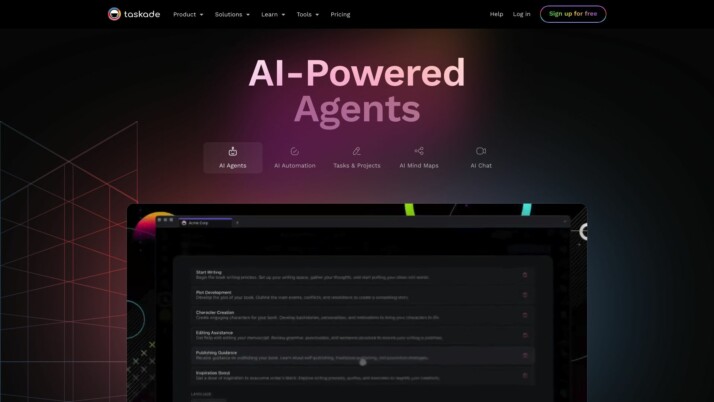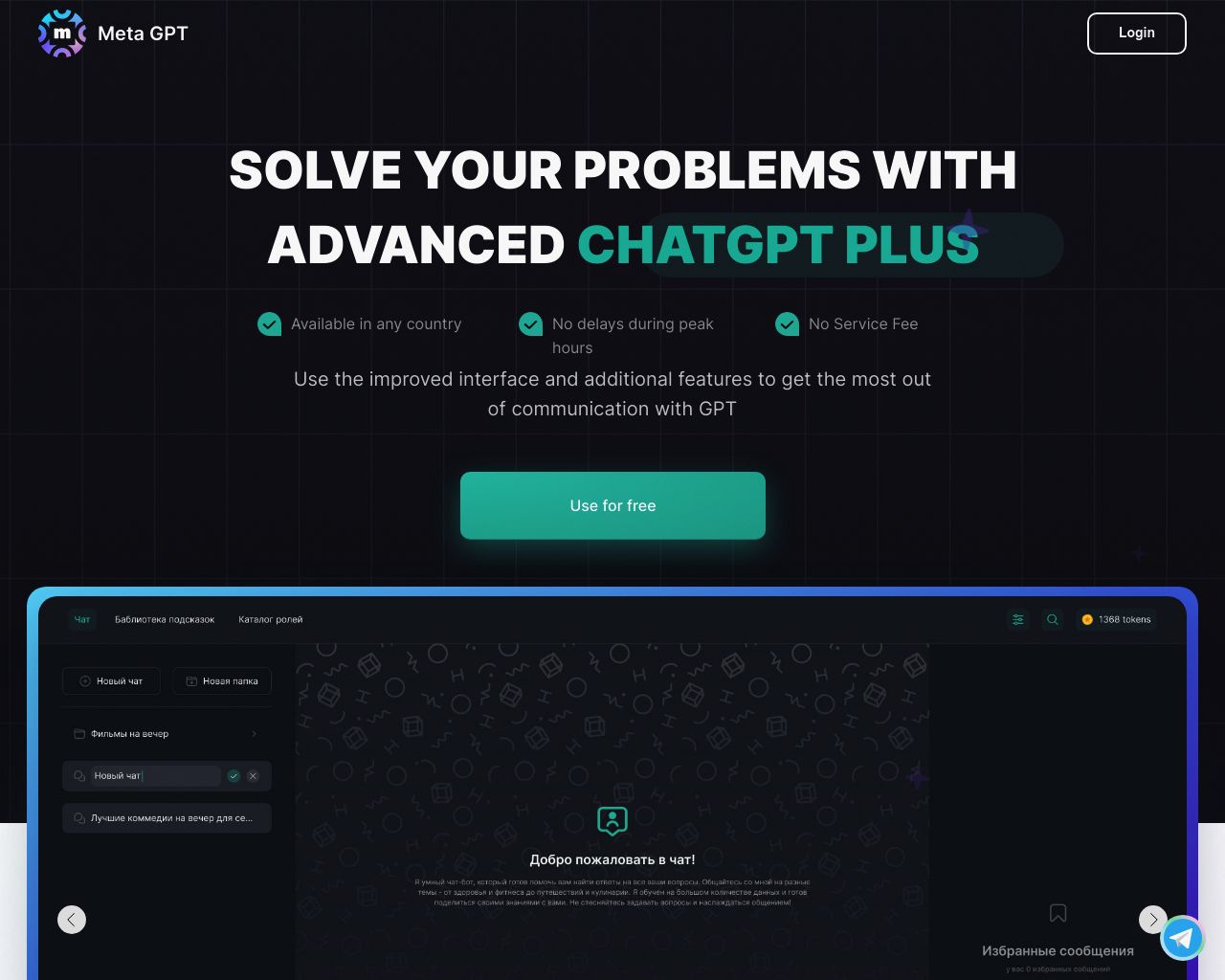Taskade vs. MetaGPT: AI Collaboration Tools Compared
AI-powered collaboration tools are reshaping how teams work, communicate, and innovate. Taskade vs. MetaGPT, and SmythOS each bring unique approaches to AI-enhanced productivity and development. This comparison delves into their core features, exploring how Taskade unifies project management with AI assistance, MetaGPT simulates software company structures for complex tasks, and SmythOS offers a versatile platform for creating and deploying AI agents across diverse applications. We’ll examine their strengths, limitations, and potential impact on various industries, helping you determine which solution best fits your organization’s needs for AI-driven efficiency and innovation.
Taskade Overview
Taskade empowers teams with a unified workspace for project management, task organization, and real-time collaboration. The platform integrates AI-powered tools to streamline workflows and boost productivity across distributed teams.


Screenshot of Taskade Website
Taskade’s AI agents, powered by GPT-4 Turbo, automate routine tasks and generate actionable insights from project data. These agents assist with research, content creation, and workflow optimization, freeing team members to focus on high-value activities. The platform’s visual builder allows users to create custom workflows and project views, adapting to diverse work styles and project requirements.
Taskade’s AI agents, powered by GPT-4 Turbo, automate routine tasks and generate actionable insights from project data. These agents assist with research, content creation, and workflow optimization…
Real-time collaboration features, including chat and video conferencing, enable seamless communication within project contexts. Taskade’s multimodal approach supports various content types, from text documents to mind maps, providing flexibility in project visualization and management. The platform’s integration capabilities, including Zapier support, allow teams to connect Taskade with over 5000 apps, enhancing automation and data flow across tools.
While Taskade offers robust features for team collaboration and AI-assisted productivity, it may not provide the same level of specialized AI development tools as platforms focused solely on AI agent creation. The platform’s strength lies in its ability to integrate AI capabilities into a comprehensive project management and collaboration ecosystem, rather than offering a dedicated environment for building standalone AI agents.
Taskade’s approach to AI integration and team collaboration positions it as a versatile solution for organizations seeking to enhance productivity through intelligent automation and streamlined project management. Its combination of AI-powered features, visual workflow tools, and real-time collaboration capabilities makes it a compelling choice for teams looking to leverage AI within their existing work processes.
MetaGPT Overview
MetaGPT revolutionizes multi-agent collaboration in AI by combining human Standardized Operating Procedures (SOPs) with advanced Large Language Models (LLMs). Developed by researchers from prestigious institutions, MetaGPT simulates a software company’s structure to tackle complex software development tasks efficiently.


MetaGPT assigns distinct roles to AI agents, mirroring traditional software company positions like product managers, architects, and engineers. This framework encodes human workflows into prompt sequences, enhancing output consistency and reliability. The core philosophy, “Code = SOP(Team),” emphasizes integrating established human practices into AI-driven processes.
MetaGPT assigns distinct roles to AI agents, mirroring traditional software company positions like product managers, architects, and engineers.
The platform’s assembly line paradigm breaks tasks into manageable subtasks handled by specialized agents. This approach ensures each agent contributes its expertise, resulting in more accurate and robust solutions. MetaGPT generates comprehensive documentation throughout the development process, including requirement documents, design artifacts, and interface specifications.
MetaGPT’s unique selling point lies in its ability to mimic and improve human collaboration within an AI framework. By incorporating SOPs and specialized roles, it ensures AI agents work together efficiently, producing high-quality outputs aligned with human standards. This approach not only enhances multi-agent system performance but also opens new possibilities for AI application in complex, real-world scenarios.
While MetaGPT offers innovative solutions for AI-driven software development, it may present challenges for users seeking a more intuitive, no-code approach or those requiring extensive customization options. The platform’s focus on simulating a software company structure could potentially limit its applicability in non-software development contexts.
Feature Comparison
SmythOS and MetaGPT both offer powerful AI agent capabilities, but with key differences in their approaches and features. MetaGPT excels at simulating a software company structure for complex development tasks, assigning specialized roles to AI agents like product managers and engineers. This approach leverages human-like workflows encoded into prompt sequences, potentially enhancing output consistency for software projects. However, MetaGPT’s focus on mimicking traditional software company processes may limit its flexibility for non-software tasks.
SmythOS provides a more versatile platform for creating and deploying AI agents across various use cases. Its visual drag-and-drop interface and no-code options make agent creation accessible to users without extensive programming knowledge. SmythOS offers robust integration capabilities, supporting connections to numerous APIs and services through platforms like Zapier. This flexibility allows for easier incorporation of AI agents into existing business processes across industries.
While both platforms support multi-agent collaboration, SmythOS’s approach appears more adaptable to diverse workflows beyond software development. SmythOS also offers advanced features like constrained alignment, data encryption, and OAuth support, addressing crucial security and compliance needs for enterprise deployments. These security measures, combined with SmythOS’s scalable architecture and multiple deployment options, position it as a more comprehensive solution for organizations looking to implement AI agents across various business functions.
Feature Comparison Table
| Taskade | MetaGPT | SmythOS | |
|---|---|---|---|
| CORE FEATURES | |||
| Hosted Agents (Dev, Production) | ❌ | ✅ | ✅ |
| Environments (Dev, Production) | ❌ | ✅ | ✅ |
| Visual Builder | ❌ | ❌ | ✅ |
| No-Code Options | ❌ | ❌ | ✅ |
| Explainability & Transparency | ❌ | ✅ | ✅ |
| Debug Tools | ❌ | ✅ | ✅ |
| Multimodal | ❌ | ✅ | ✅ |
| Multi-Agent Collaboration | ❌ | ✅ | ✅ |
| Audit Logs for Analytics | ❌ | ✅ | ✅ |
| SECURITY | |||
| Constrained Alignment | ❌ | ✅ | ✅ |
| IP Control | ❌ | ❌ | ✅ |
| COMPONENTS | |||
| Foundation AIs | ❌ | ✅ | ✅ |
| Huggingface AIs | ❌ | ✅ | ✅ |
| Zapier APIs | ❌ | ✅ | ✅ |
| All other APIs, RPA | ❌ | ✅ | ✅ |
| Classifiers | ❌ | ✅ | ✅ |
| Logic | ❌ | ✅ | ✅ |
| Data Lakes | ❌ | ❌ | ✅ |
| DEPLOYMENT OPTIONS (EMBODIMENTS) | |||
| Deploy as API | ❌ | ✅ | ✅ |
| Deploy as Webhook | ❌ | ✅ | ✅ |
| Staging Domains | ❌ | ❌ | ✅ |
| Production Domains | ❌ | ✅ | ✅ |
| API Authentication (OAuth + Key) | ❌ | ✅ | ✅ |
| Deploy as Site Chat | ❌ | ✅ | ✅ |
| Deploy as Scheduled Agent | ❌ | ✅ | ✅ |
| Deploy as GPT | ❌ | ✅ | ✅ |
| Scalability | ❌ | ✅ | ✅ |
| DATA LAKE SUPPORT | |||
| Hosted Vector Database | ❌ | ❌ | ✅ |
| Sitemap Crawler | ❌ | ❌ | ✅ |
| YouTube Transcript Crawler | ❌ | ❌ | ✅ |
| URL Crawler | ❌ | ✅ | ✅ |
| Word File Support | ❌ | ✅ | ✅ |
Best Alternative to Taskade and MetaGPT
SmythOS stands out as the superior alternative to Taskade and MetaGPT for AI agent development and deployment. Our platform offers unparalleled versatility and ease of use, empowering users to create sophisticated AI agents without extensive coding knowledge. SmythOS’s visual drag-and-drop interface simplifies the process of building complex AI workflows, making advanced AI functionalities accessible to a wider audience.
SmythOS stands out as the superior alternative to Taskade and MetaGPT for AI agent development and deployment. Our platform offers unparalleled versatility and ease of use…
Unlike Taskade’s focus on collaborative workspaces and MetaGPT’s emphasis on simulating software company structures, SmythOS provides a comprehensive ecosystem for AI agent creation across diverse industries and use cases. We excel in offering pre-built API integrations and support for various AI models, enabling seamless connections to data sources and services. This flexibility allows users to rapidly develop and deploy AI solutions tailored to their specific needs.
SmythOS distinguishes itself with robust security features, including constrained alignment and data encryption, addressing crucial enterprise-level concerns. Our platform supports multiple deployment options, from APIs and webhooks to site chats and scheduled agents, ensuring versatility in how AI agents can be utilized. Additionally, SmythOS offers scalable architecture and extensive integration capabilities, making it ideal for organizations looking to implement AI across various business functions.
While Taskade and MetaGPT have their strengths in collaboration and software development simulation respectively, SmythOS provides a more holistic approach to AI agent creation. Our platform combines the accessibility of no-code options with the power of advanced AI capabilities, offering a solution that grows with your needs. From small businesses to large enterprises, SmythOS delivers the tools necessary to harness the full potential of AI, driving innovation and efficiency across industries.
Conclusion
Taskade and MetaGPT offer unique approaches to AI-powered collaboration and development, each with its own strengths. Taskade excels in providing a unified workspace for project management and real-time collaboration, integrating AI tools to enhance productivity. Its visual workflow builder and AI-assisted content creation cater well to teams seeking seamless project coordination. MetaGPT, on the other hand, brings innovation to multi-agent collaboration by simulating a software company structure, making it particularly suited for complex software development tasks.
While both platforms demonstrate the potential of AI in enhancing teamwork and productivity, SmythOS emerges as the superior choice for businesses looking to harness the full power of AI across various applications. SmythOS’s versatility shines through its extensive integration ecosystem, supporting over 300,000 integrations and a wide range of AI models. The platform’s drag-and-drop interface democratizes AI development, allowing users to create sophisticated AI workflows without extensive coding knowledge.
SmythOS’s “Create Once, Deploy Anywhere” approach sets it apart, offering unparalleled flexibility in deploying AI agents across multiple platforms and services. This feature, combined with robust security measures like data encryption and OAuth support, makes SmythOS an ideal solution for enterprises seeking scalable and secure AI implementations. The platform’s ability to handle multimodal interactions, support problem-solving capabilities, and facilitate multi-agent collaboration positions it as a comprehensive tool for businesses looking to innovate and automate at scale.
For those ready to explore the cutting-edge of AI automation and integration, we invite you to get started with SmythOS. Experience firsthand how our platform can revolutionize your workflow, offering a risk-free opportunity to create unlimited AI agents and automate complex tasks. Discover our diverse range of AI-powered agent templates to jumpstart your journey into the future of work, or dive into our comprehensive documentation to unlock the full potential of SmythOS for your business needs.
Last updated:
Disclaimer: The information presented in this article is for general informational purposes only and is provided as is. While we strive to keep the content up-to-date and accurate, we make no representations or warranties of any kind, express or implied, about the completeness, accuracy, reliability, suitability, or availability of the information contained in this article.
Any reliance you place on such information is strictly at your own risk. We reserve the right to make additions, deletions, or modifications to the contents of this article at any time without prior notice.
In no event will we be liable for any loss or damage including without limitation, indirect or consequential loss or damage, or any loss or damage whatsoever arising from loss of data, profits, or any other loss not specified herein arising out of, or in connection with, the use of this article.
Despite our best efforts, this article may contain oversights, errors, or omissions. If you notice any inaccuracies or have concerns about the content, please report them through our content feedback form. Your input helps us maintain the quality and reliability of our information.
